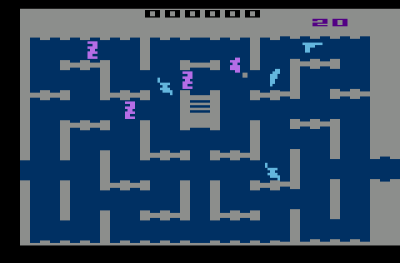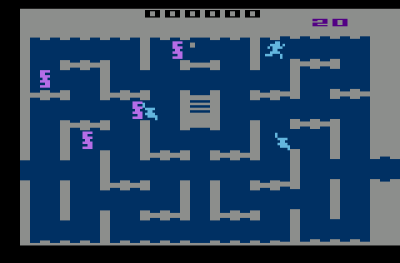[Break Time! is a series of posts about video games that Rick has spent entirely too much time with over the years.]
One of my hobbies is collecting and restoring old video game systems. Not arcade machines, since I don’t have a house nearly large enough for a bunch of arcade machines, but consoles.
As a kid, I owned an Atari 2600 console – which gave me years of entertainment until it had an unfortunate run-in with a thunderstorm. Many years later, I bought a secondhand Atari 2600 at a flea market, then dug my old cartridges out of the attic. I was bitten by the collecting bug, and now I have a “library” of old game consoles and their games.

There are some who say that Atari 2600 games were the best games ever made. I am not one of those people. As someone who owns nearly three hundred different Atari cartridges, I’ll go on record to state that most of the Atari 2600 cartridge library is complete crap. The only entertainment value many of these games had was the “wow” factor: you could actually control the images on the television screen!
In 2007, most of the Atari 2600 game library is worthless – unless you’re interested in the evolution of video games. But there are some games that stand out; games that were more than just moving blocks around on the television screen. Dark Cavern, by Mattel (a.k.a. “M Network”) is one of those games.

You are a man in an unfortunate situation. You have a gun, and are thrown into a dungeon populated by spiders (which paralyze you), bulletsuckers (which … suck your bullets away), and killer robots. The robots chase you around the dungeon relentlessly, and shoot at you if they “see” you. You can shoot back at all of these enemies. There’s a catch: You can run out of bullets, but the robots have an endless supply.
You can scrounge up more bullets by picking up a flashing “gun” that appears occasionally in the dungeon. This is often harder that it sounds; the gun often pops up in the midst of a gang of robots, and disappears if you don’t claim it quickly enough. Such is life in the Dark Cavern.
On the easiest difficulty level, you initially battle only two robots. Once you blow away enough robots, the game sends out three robots at a time. Then four. The robots get faster as you kill more of them. They also get “smarter”. Earlier robots can only shoot in the direction they’re facing. Later robots rotate their heads to face in all directions – making it impossible to score an easy kill by sneaking up behind a robot.
(These screen shots were taken on the highest difficulty setting – four robots with rotating heads.)

As you run, hide, and shoot, you hear the roar of the robots prowling the dungeon – a sound that changes depending on how many robots are in the maze. If you’ve managed to blast all the robots, it’s eerily quiet – until the next batch of smarter, faster robots thunders in to kill you.
All in all, Dark Cavern is a surprisingly intense game. It’s one of the rare group of Atari titles that will actually entertain you in 2007. Or at least, it will entertain you until the killer robots blow you away. And they will blow you away. This is an old-school game which cares nothing for your self esteem. You will not win.
… but you might get a high score.
Additional note: Dark Cavern is one of the few games of its era to have “friendly fire”. The robots can and will occasionally shoot each other trying to get you. In Dark Cavern, a bullet is a bullet.

good news
thank you for infos
Cool post,
I’m JUST old enough to remember the Atari era quite well, though I never played Dark Cavern. The two games I remember most fondly on the Atari (aside from games like Pac Man and Frogger that were available on other consoles) were “Spiderman” and “Sneak & Peek”. The Spiderman game is pretty self explanatory, you were Spidey and had to scale numerous buildings with your webbing while avoiding bombs being thrown at you by the Hobgobblin. Sneak & Peek was a little more complex. As far as I know, it was the first “interactive” video game ever made. It was basically a video game version of hide and go seek. The player who was doing the hiding would manuever his man through a series of rooms in a house (or you could go outside the house) and find a place to hide. You could hide in closets, under furniture, behind curtains etc. The person playing as the seeker would have to cover their eyes and/or turn their head while the other player found a place to hide. Once your man was hidden, the 2nd player would uncover their eyes and search throughout the house trying to find you within a set time limit. I fondly enjoyed both of these games growing up. I had a chance to play them again with an Atari emulator, and in retrospect they were a lot more primitive than I had remembered. I played each one for about 5 min before I was bored to death. I couldn’t even keep playing it for the nostalgia. Ahhh well. Also, I think it would a neat idea if you could do a write up on the Intellevision console. Do you remember that? I never had one as a kid, and never actually saw one until I came across one at a yard sale in mid 90’s. I bought the system and 7 or 8 games for around 2 dollars. It was so old that it didn’t even have a coaxial cable adapter (or RCA cables). It had a little box with two little forks coming out of it. You had to hook the forks up to two screws on the back of your tv set for the thing to work. It also had the most complex joystick I have ever seen. It had a huge number pad, almost like a telephone, with the digits 0-9 and a # and * keys. And instead of an analog stick it had this large knobbed dial that you would turn left or right to controll certai movements. It was definately different. Another good idea for a write up might be to do a timeline on the history of adventure games. Adventure games are my favorite genre, and there have been plenty of entries in to it over the years. I think it would interesting to see how much progress has been made in the 30 years or so since they’ve been in the mainstream. I did a little looking around online for articles on the topic, and I came across a few that were worthwhile, like this one. I’d be interested in reading your take on the history of the genre, and seeing what approach you take in highlighting certain key games. Hopefully, you’ll decide to do a write up on it when you you have the time. Thanks again for the cool post. Your blog is always a great read. Keep up the good work!